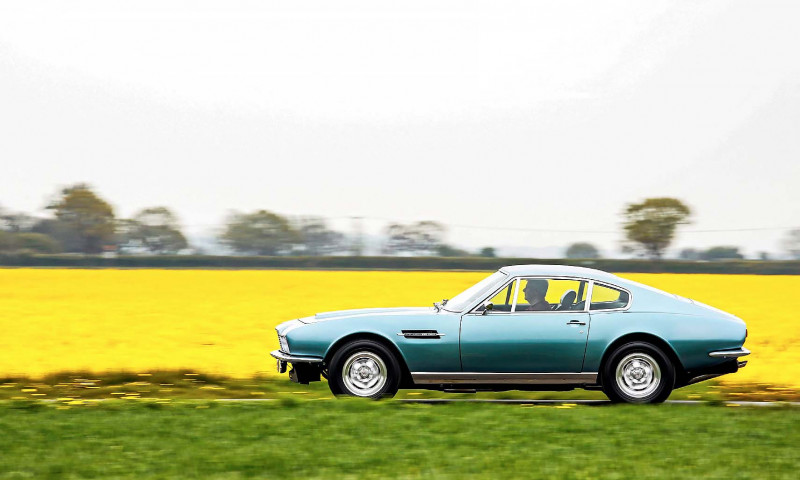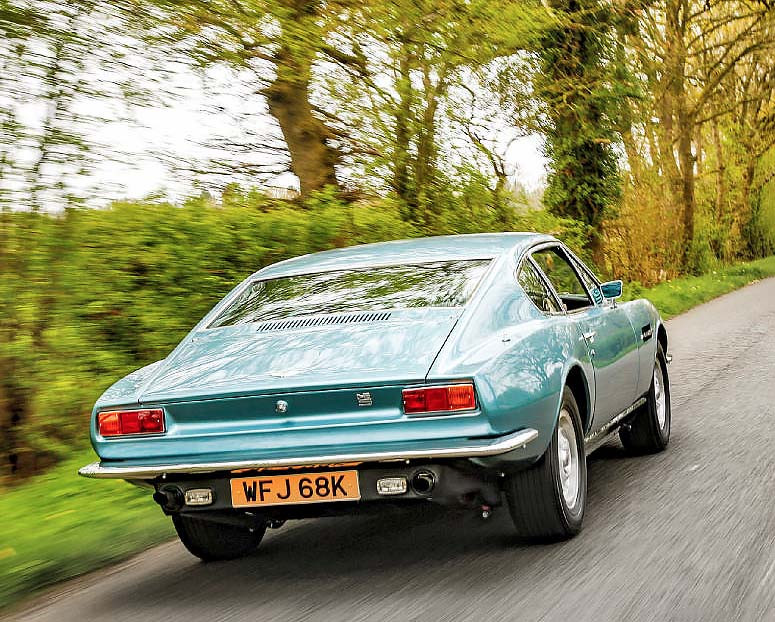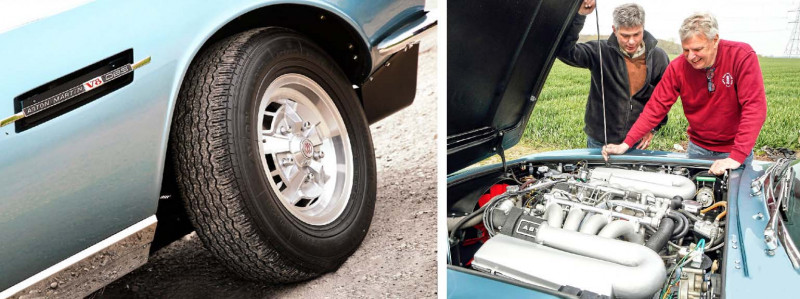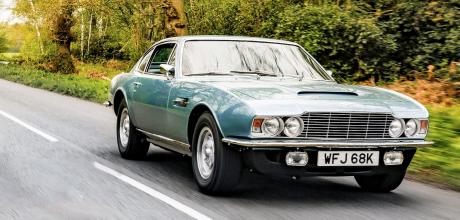1971 Aston Martin DBS V8
Reliant Scimitar enthusiast Jim Pace has always fancied spending a day in an Aston Martin DBS V8 playing Roger Moore from The Persuaders! Today we make it happen.
Words ANDREW NOAKES
Photography TOM CRITCHELL
‘It’s a bar-room brawler in a Savile Row suit’
The List One lucky reader spends a day with a besuited brawler — Aston Martin DBS V8
We make one reader’s DBS Persuaders! fantasy real
Roger Moore, Tony Curtis, a bright red Dino and a yellow Aston: the key ingredients for first episode of The Persuaders!, an action/ adventure/mystery series that hit British TV screens in 1971. Never mind that the Bahama Yellow Aston was a mere six-cylinder DBS dressed up and dubbed to look and sound like the latest V8 – it still caught the attention of petrolheads everywhere.

‘I was about 14 when The Persuaders! came out,’ says Classic Cars reader Jim Pace. ‘At the time I would’ve liked the Ferrari Dino but as I’ve got older, it’s the Aston Martin that I appreciate more. I was never a huge fan of the Aston DB5 in the Bond movies, but when On Her Majesty’s Secret Service came out and George Lazenby was driving a DBS, that really appealed – even though I think the only special thing about it was a gun in the glovebox.’
‘It’s got that offbeat kind of burble to it, and the mechanical noise of having the four camshafts helps as well’
Jim has run a series of Reliant Scimitars, and is editor of the Reliant Sabre and Scimitar Owners Club magazine. He’s also restoring a prototype Anadol, the GRP-bodied two-door designed by Reliant for the Turkish Otosan company to build in Istanbul. But he’s taking a day off from all things Reliant because we’ve arranged to meet at Aston Martin specialist Richards of England near Lincoln, where boss Paul Richards has a superb DBS V8 manual for Jim to live out a few Roger Moore fantasies. ‘I like front-engined, rear-wheel driven, British GT cars,’ Jim declares. Clearly the Aston DBS V8 ticks those boxes. It was around at the right time too. ‘I was born in 1958 and I started reading car magazines at four years old,’ he remembers. ‘I found a pile of Car Mechanics magazines in a drawer in my father’s office. My mother reckons I could read about cars before I could read Andy Pandy or Enid Blyton. Then I moved on to Hot Car, and later Custom Car and Cars and Car Conversions. I was reading about the new cars of the Sixties and Seventies, and sometimes harking back to the Fifties.’

The Azzuro blue Aston is waiting for us outside the Richards of England workshop, sunshine glinting off its chrome exterior details. ‘I think it’s one of the most gorgeous cars ever built,’ Jim says. ‘I just love the appearance. It’s got a big, muscular V8oger Moore, Tony Curtis, a bright red Dino and a yellow Aston: the key ingredients for first episode of The Persuaders!, an action/ adventure/mystery series that hit British TV screens in 1971. Never mind that the Bahama Yellow Aston was a mere six-cylinder DBS dressed up and dubbed to look and sound like the latest V8 – it still caught the attention of petrolheads everywhere.
‘People talk about all the Italian styling houses, but William Towns got this one absolutely spot on’
‘I was about 14 when The Persuaders! came out,’ says Classic Cars reader Jim Pace. ‘At the time I would’ve liked the Ferrari Dino but as I’ve got older, it’s the Aston Martin that I appreciate more. I was never a huge fan of the Aston DB5 in the Bond movies, but when On Her Majesty’s Secret Service came out and George Lazenby was driving a DBS, that really appealed – even though I think the only special thing about it was a gun in the glovebox.’

Jim has run a series of Reliant Scimitars, and is editor of the Reliant Sabre and Scimitar Owners Club magazine. He’s also restoring a prototype Anadol, the GRP-bodied two-door designed by Reliant for the Turkish Otosan company to build in Istanbul. But he’s taking a day off from all things Reliant because we’ve arranged to meet at Aston Martin specialist Richards of England near Lincoln, where boss Paul Richards has a superb DBS V8 manual for Jim to live out a few Roger Moore fantasies.
‘I like front-engined, rear-wheel driven, British GT cars,’ Jim declares. Clearly the Aston DBS V8 ticks those boxes. It was around at the right time too. ‘I was born in 1958 and I started reading car magazines at four years old,’ he remembers. ‘I found a pile of Car Mechanics magazines in a drawer in my father’s office. My mother reckons I could read about cars before I could read Andy Pandy or Enid Blyton. Then I moved on to Hot Car, and later Custom Car and Cars and Car Conversions. I was reading about the new cars of the Sixties and Seventies, and sometimes harking back to the Fifties.’

The Azzuro blue Aston is waiting for us outside the Richards of England workshop, sunshine glinting off its chrome exterior details. ‘I think it’s one of the most gorgeous cars ever built,’ Jim says. ‘I just love the appearance. It’s got a big, muscular V8 engine in a very, very elegant body, and I think that’s a fabulous combination. It’s a bar-room brawler in a Savile Row suit.’ Most cars work better from some angles than others, but as we walk around the DBS we struggle to find a line out of place.
‘Look at it from anywhere and there’s something interesting,’ Jim says. ‘Absolutely beautiful. The modifications that were made during its life for the Oscar India series and the Vantage only enhanced it – but I still love that original four-headlamp front end. It’s got a simplicity and an elegance to it. People talk about all the Italian styling houses, but really William Towns got this one absolutely spot on for me. It’s before he went for “folded paper” wedges and it’s got subtle curves in it, which is lovely.’
Popping open the front-hinged alloy bonnet we marvel at the sheer scale of the 5.3-litre V8 engine. It’s fed by magnificently extravagant intakes for the Bosch fuel injection system, which Aston soon abandoned in favour of old-school Weber carburettors. ‘The detailing is fantastic,’ Jim says. ‘Flawless black crackle finish on the cam covers, twin bonnet stays with beautiful heavy chrome. It even has Aston-branded plug leads.’
Jim pulls the thick driver’s door open and settles into the black leather-clad cabin, where there’s plenty of room for his six-foot frame. ‘For a grand touring car there’s loads of space in here. It’s designed to carry four people across continents and it would do that. The rear seats are small but not too bad for this class of car, and the driver’s seat is extremely comfortable – it’s midway between an armchair and a bucket seat. It gives good support, and the leather is really good quality – Connolly I imagine. It’s a light, airy cabin even if it is trimmed in black.’ But some areas of the interior are surprisingly crude. ‘The chrome windscreen pillar trims are fitted with a couple of self-tapping screws, with the screw heads left exposed. And some of the switchgear is standard Lucas stuff that you see in an Austin 1100 or Maxi. That sort of thing was typical of the period for a specialist car like this.’
The V8 churns away on the starter before it fires and Jim selects first gear in the dog-leg ZF ‘box, reporting that the clutch effort is on the heavy side. ‘With a conventional pendant pedal you leave your foot on the floor and rock from the heel but this is like a Beetle clutch pedal, hinged at the bottom. I cut my teeth on air-cooled Volkswagens and the technique is to take the foot off the floor and push down with the ball of your foot, because you get a lot more strength through your leg than you do through your ankle. The clutch is actually very progressive and easy to get used to.
These Lincolnshire lanes have plenty of pockmarks and jarring surface changes, but the Aston feels solid. ‘It doesn’t rattle, and doesn’t feel like the two ends of the car are going in different directions over the bumps,’ Jim says. ‘There’s no sense of flex in it at all. There’s clearly tremendous torsional rigidity in that steel chassis.’ The busy road surface doesn’t give the suspension a moment’s respite. ‘You’re well insulated from the road imperfections,’ Jim points out. ‘Considering Aston Martin was quite a small firm, and living on the edge of bankruptcy constantly, it didn’t have a limitless engineering budget. It must have had some terrific, first-class engineers in there working on the thing because it feels very cohesive and well developed.’ Independent front suspension using double wishbones and a sophisticated de Dion axle at the rear make for consistent grip. ‘I expected it to be nervous and feel on the edge all the time. It’s anything but. Coming out of a corner, you just sense that if you were to absolutely boot it, it would just squat and go. It’s reassuring, and gives you tremendous confidence in the car.’
The upturned edges of the front wings define the extremities of the Aston effectively, and the precision of the steering makes it easy to place the DBS on the road, despite its not inconsiderable width. ‘These are relatively narrow roads and there’s traffic coming towards us but I feel like I know where the car is – how far it is from the kerb or the grass verge,’ Jim says. ‘Around a corner, you know where the car is relative to the apex and the line to take, and you can place the car perfectly. Really impressive.’
The soundtrack provided by that hand-built, quad-cam V8 is wonderful, too. ‘I think any cross-plane crank V8 sounds good,’ says Jim. ‘It’s got that offbeat kind of burble to it. And the extra mechanical noise of having the four camshafts helps as well. From what I’ve read about the injection system I was expecting it to be a pig to drive at low speed and it isn’t. It’s torquey and you can drop it into fifth at very low revs and low speeds. And it’s actually a gentle car to drive if you want it to be. I’m sure you could stick it in first, let out the clutch carefully and it would just trickle away at idle. It’s that progressive. And then when you want you can floor it or drop a couple of gears and it takes off.’
Jim’s had no problems adapting to the dog-leg gearbox, with first gear to the left and back. ‘I expected for it to cause me all sorts of problems, but it hasn’t. And part of the reason for that is because the change is so mechanical and deliberate, in a good way. Out of first gear the lever falls over towards the centre and it’s easy to guide it forward into second. You can’t flick it vaguely around the gate – you have to be positive. That helps because it means you’re always thinking about the gearbox and the gearchange pattern.’
Jim’s time in the Aston has underlined the similarities between the DBS V8 and his Scimitars. ‘Front engine, rear-wheel drive, British GT car. The Scimitars usually have a V6, rather than the Aston’s V8, but the principles are the same. You can kind of see a connection between the two in terms of what they do. The Aston Martin is by far the better car, as it should be, given what it cost when new and what it’s worth now – there’s no question about that – but the Scim will do as a substitute for me.’
The Aston, meanwhile, more than justifies its place on Jim’s dream drives list. ‘Without question,’ he says. ‘My fear going into this was how do I cope with the disappointment if it doesn’t live up to the promise? And how would I find nice things to say about it if it was awful?’ Jim says. ‘But I haven’t had that problem. There were a couple of niggles, but that’s all. At first the steering wheel felt a bit distant and I thought it could do with an adjustable steering column to bring it a bit closer. But after I’d driven it for a while I could see that, coming back to the grand touring purpose of the car, you’d sit back, relax and let the power assistance do the work as you cruised at 120mph or whatever down to the south of France. It’s been designed around those parameters in terms of the ergonomics of it.’
Another issue was visibility when reversing. ‘The rear screen is a letter box, and you can’t see how much car there is behind,’ Jim explains. ‘It also surprised me how petite the mirrors were – you get a nice view of the curve of the rear wing, which is lovely, but not a lot of help reversing. I’d need a bit of practice, or I might have to drill holes in the back and put in reversing sensors!’
Jim’s certainly enjoyed his time behind the Aston’s steering wheel. ‘I’ve just loved it. The style of it, the shape of it, the feel of it, the drive, the sound of it, the details under the bonnet. Plus the romance of the history of Aston Martin, and the film and TV background of the DBS. It’s been a stunning experience.
Thanks to: Paul Richards and the team at Richards of England (richardsofengland.com)
Rear visibility issues aside, the DBS has been everything Jim hoped for
TECHNICAL DATA 1971 Aston Martin DBS V8
- Engine 5340cc V8, dohc per bank, Bosch mechanical fuel injection
- Max Power 345bhp @ 6000rpm
- Max Torque 330lb ft @ 5000rpm
- Transmission Five-speed manual, rear-wheel drive
- Steering Power-assisted recirculating ball
- Suspension Front: independent, double wishbones, coil springs, telescopic dampers, anti-roll bar Rear: de Dion, coil springs, telescopic dampers and Watt linkage
- Brakes Servo-assisted discs all round
- Performance Top speed: 170mph
- Acceleration 0-60mph: 6.0sec
- Weight 1727kg (3807lb)
- Fuel consumption 15mpg
- Cost new £7501 in 1971
- Classic Cars Price Guide £35,000-£115,000
Some switchgear does nothing for the Aston’s perceived quality. Jim finds the recirculating-ball steering pleasingly precise.
No problems with the notorious fuel injection system today Unlike Roger Moore’s car, this DBS’s V8 badges and wheels are honest.
Jim rates the rich feel of the Connoly leather.



Different impressions
As a schoolboy I bought Motor or Autocar most weeks from the mid-Sixties to the early Seventies, carefully removing the road tests, which I still have. It’s fascinating to compare your and your readers’ impressions of classics with those of contemporary road-testers. With the Aston DBS V8, reader Jim Pace noted the heavy clutch, and that the car ‘churns away on the starter’ before firing, and commented that some areas of the interior were crude. In July 1971 Autocar noted a 50lb effort needed for the clutch and 45 seconds of churning to start the engine. That they made no comment about the crudeness of the switchgear says much about how such things have improved over the years. In the Autocar March 1968 test of the Jensen FF, its four-wheel drive and ABS system made the car remarkably advanced. On paper it’s surprisingly similar to my Bentley Continental GT. I’d love to compare the two side by side!